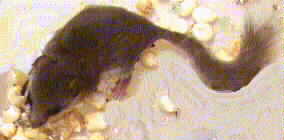The
Dormouse - not a "Mouse" at all!
This is an Edible or Fat Dormouse also known as Glis glis.
There is a little bit of confusion today
about different species of dormice. I hope this will begin to clear up the
mis-information that some of you may have read or heard.
The two main genera of dormice that are being sold in the US today are the
smaller African Dormouse, Graphiurus murinus and the larger Edible
or Fat Dormouse, Glis glis. There are a few major differences between
the two genera. For the sake of simplicity, we will refer to them as the small
and the large.
The small dormouse is also referred to as the African dormouse although both
genera are from Africa. Its head-body length is about 2 inches long with a
tail of nearly equal length. They weigh about 1/2 ounce. Their fur is very
soft with colors of various shades of gray and brownish gray. Their underparts
are lighter in color. Their head is rather flat which enables them to squeeze
into the tiniest of places. They are able to climb vertically even if there
is poor gripping surface. Then may have two litters a year of from 1 to 5
babies. They have lived up to 6 years in captivity.
This is an African Dormouse. These 2 photos courtesy of Johnny
Stikman
The large dormouse is also referred to as glis glis. They are from
5 to 8 inches long with a tail about 2/3's the body length. They weigh between
2 and 6 ounces. Their fur is thick and soft and gray or brown except for the
underparts which are lighter. It resembles a squirrel with large rounded ears
and its thick bushy tail. It normally has one litter per year in the wild,
although with proper climatic conditions in captivity, they may have two litters
in one year. Gestation is 20-30 days with litters of from 2 to 10 babies.
They have lived to eight years in captivity. Both types may be fed a similar
diet of seeds, nuts, fruits, insects, hard-boiled eggs and small bits of meat
such as chicken.
Both species will hibernate if the climate is cool, the days are short and/or
the food is not adequate. To prevent hibernation, we suggest a 14 hour light
cycle to simulate summer sun light. These animals MUST have an extra layer
of fat before they go into hibernation, or they may not survive.
Dormice babies, photo courtesy of Debbie Dillon
R-Zu-2-U Home
R-Zu-2-U FAQs
R-Zu-2-U Animal "Terms"
Treasure Ranch Home




